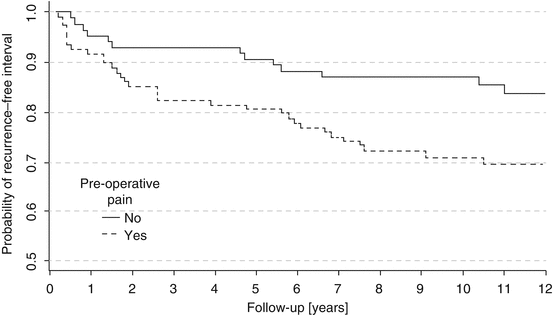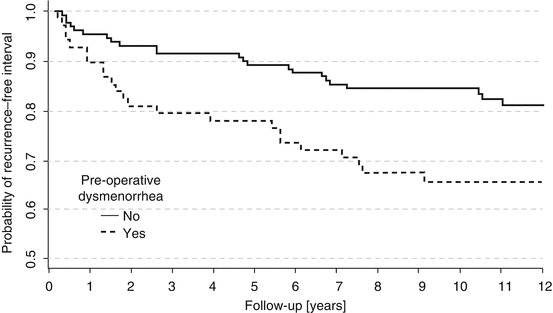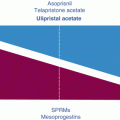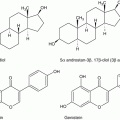Fig. 15.1
Transvaginal ultrasonogram of a 6-cm (diameter), left ovarian endometrioma and its corresponding laparoscopic image
Table 15.1
Patient characteristics (n = 550)
Factors | Number of cases (%) | |
Age (years) | 37.2 ± 9.0a | |
BMI (kg/m2) | <19 | 43 (7.8) |
19–24 | 344 (62.5) | |
25–30 | 123 (22.4) | |
>30 | 40 (7.3) | |
Sterility | Primary | 261 (47.5) |
Secondary | 52 (9.5) | |
Parity | ≥1 | 194 (35.3) |
Abortion or miscarriage | ≥1 | 72 (13.1) |
Pain | 338 (61.5) | |
Dysmenorrhea | 214 (38.9) | |
Recurrence of previous endometrioma | 153 (27.8) | |
Previous laparoscopic surgery of ovarian endometrioma | 226 (41.1) | |
Presence of uterine myoma | 105 (19.1) | |
CA-125b (U/ml) | Increased (>35 U/ml) | 147 (47.6) |
Cyst size (cm) | 2–4 | 316 (57.5) |
5–8 | 209 (38.0) | |
>8 | 25 (4.5) | |
Cyst rupture | Preoperative | 23 (4.2) |
Intraoperative | 281 (51.1) | |
Follow-up patient characteristics ( n = 289) | ||
Age (years) | 50.5 ± 9.3a | |
Postoperative medical treatment | 162 (56.1) | |
Postoperative pain | 96 (33.2) | |
Postoperative dysmenorrheab | 93 (34.8) | |
Recurrence of first diagnosed ovarian endometriomab | 47 (23.9) | |
Reoperation rate of first diagnosed ovarian endometriomab | 32 (68.1) | |
Postoperative pregnancy desire | 111 (38.4) | |
Postoperative pregnancyb | 60 (54.1) | |
Data for analysis were recorded using Microsoft (Redmond, Washington) Access software. Statistical analysis was performed using Microsoft Excel and SPSS (IBM Corporation, Armonk, New York) programs. Patient identification numbers were assigned for granting data protection. The percentages are based primarily on the total number; in the absence of information, the corrected probability is given. In the analysis of categorical values, the χ2 was used. The statistical significance level was set at 5 % (P < .05). The recurrence-free interval probabilities were estimated according Kaplan-Meier method. The log-rank test (Mantel-Cox) was used to compare the survival time of two groups with each other. In postmenopausal cases, the women were not considered in the postoperative analysis of dysmenorrhea [1].
15.3 Results
At the time of surgery, the mean age of all endometrioma patients was 37.2 (±9.0) years and at follow-up, 50.5 (±9.3) years (Table 15.1). Preoperatively younger age, nulliparity, and previous laparoscopic surgery for ovarian endometrioma predicted positively the presence of pain and dysmenorrhea. Larger cyst size (>8 cm) was also associated with occurrence of pain, while primary or secondary sterility was associated with a higher rate of dysmenorrhea.
Factors associated with recurrence of dysmenorrhea were younger age (P < .01), nulliparity (P < .05), and lager cyst size (P < .05). Previous laparoscopic surgery for ovarian endometrioma (P < .05) was the only significant risk factor for recurrence of pain that was found (Table 15.2).
Table 15.2
Analysis of factors related to the occurrence and recurrence of pain and dysmenorrhea
Factors | Preoperative | Postoperative | Preoperative | Postoperative |
|---|---|---|---|---|
Pain | Dysmenorrhea | |||
P-value (n = 550) | P-value (n = 289) | P-value (n = 550) | P-value (n = 267) | |
Younger age (years) | <0.01 | NS | <0.01 | <0.01 |
BMI (kg/m2) | NS | NS | NS | NS |
Sterility | NS | NS | <0.01 | NS |
Nulliparity | <0.05 | NS | <0.05 | <0.05 |
Abortion/miscarriage | NS | NS | NS | NS |
Previous laparoscopy of endometrioma | <0.01 | <0.05 | <0.05 | NS |
Lager cyst size (>8 cm) | <0.05 | NS | NS | <0.05 |
Cyst rupture | NS | NS | NS | NS |
One hundred ninety-seven patients were initially diagnosed with endometriomas at the time of surgery, and, of those, 47 patients showed recurrent ovarian endometrioma (23.9 %) in the follow-up period. Of those 47 patients, 68.1 % (32 of 47) underwent a reoperation in the follow-up period (Table 15.1). Of those 32 patients, 17 patients (53.1 %) needed 1 reoperation, 9 patients (28.1 %) needed 2 reoperations, and 6 patients (18.8 %) required ≥3 reoperations due to new endometriosis cysts. The probability of a recurrent-free interval was 76.1 % for all primarily diagnosed endometriomas in our study period.
Patients with preoperative pain showed a significantly higher recurrence rate (log-rank test P = .013). The Kaplan-Meier graph demonstrates that patients without preoperative pain had a significantly higher recurrence-free interval of 84.7 % when compared with patients with a history of preoperative pain who were recurrence-free only 69.4 % by the end of the follow-up period (Fig. 15.2). Another statistically significant risk factor for endometrioma recurrence was preoperative dysmenorrhea (log-rank test P = .013). The Kaplan-Meier curve (Fig. 15.3) illustrates that women without preoperative dysmenorrhea have a recurrence-free interval of 81.4 % compared with a recurrence-free interval of only 66.2 % in women with preoperative dysmenorrhea.



Fig. 15.2
Probability of recurrence-free interval within the follow-up period in patients with and without preoperative pain (By courtesy of Maul et al. [1])

Fig. 15.3
Probability of recurrence-free interval within the follow-up period in patients with and without preoperative dysmenorrhea (By courtesy of Maul et al. [1])
Other risk factors that were not significant but showed an association with higher recurrence were larger cyst size (>8 cm; rate of recurrence was 33.3 % [5 of 15] vs 16.3 % [15 of 92] in cyst size 5–8 cm and 16.8 % [24 of 143] in cyst size <5 cm), younger age at surgery (<25 years: 6.4 % [3 of 47] in the recurrence cohort vs 2.8 % [8 of 289] in the follow-up cohort), and preoperative cyst rupture (rate of recurrence was 28.6 % [2 of 7] in laparoscopic surgery vs 20.5 % in laparotomy.
In the follow-up period postoperative medical treatment [26 of 101] in the intraoperative cyst rupture group and 15.4 % [18 of 99] in the no-cyst rupture group showed no statistical significant differences.
Analyzing the effectiveness of endometrioma surgery, laparoscopy showed the best results in terms of being symptom-free postoperatively. After laparoscopic surgery, 49.0 % of the patients were symptom-free, while after laparotomy, only 33.3 % were. By transition from laparoscopy to laparotomy, only 43.7 % were asymptomatic.
Stay updated, free articles. Join our Telegram channel

Full access? Get Clinical Tree





